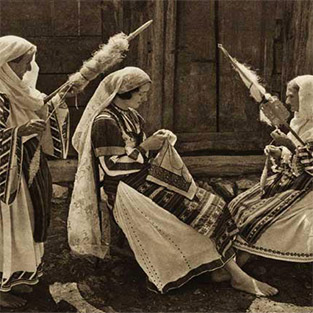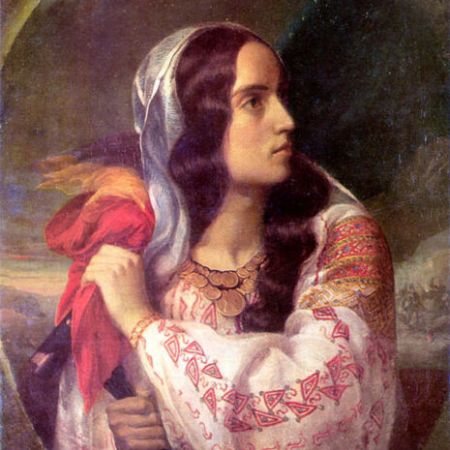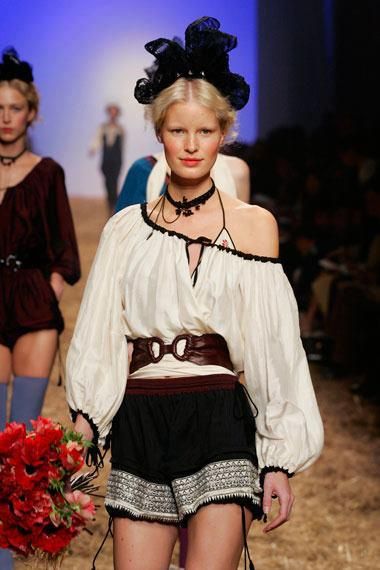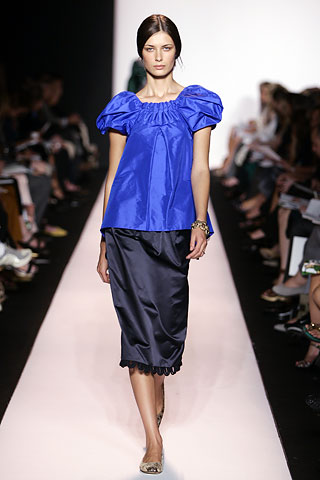“De nouveau la guerre. Il y a ici un tel cafard, une angoisse générale qui vient de tout ce qui se dit et répète sur la prochaine occupation de Nice que j’en suis très affecté par contagion et que mon travail est particulièrement difficile. Heureusement je viens de finir presque un tableau commencé il y a un an et que j’ai mené à l’aventure -en somme chacun de mes tableaux est une aventure. D’abord très réaliste, une belle brune dormant sur ma table de marbre au milieu de fruits, est devenue un ange qui dort sur une surface violette -le plus beau violet que j’aie vu, -ses chairs sont de rose de fleur pulpeuse et chaude -et le corsage de sa robe a été remplacé par une blouse roumaine ancienne, d’un bleu pervenche pâle très très doux, une blouse de broderie au petit point vieux rouge qui a dû appartenir à une princesse, avec une jupe d’abord vert émeraude et maintenant d’un noir de jais. Que tu es belle, ma messagère au bois dormant! tes yeux sont des colombes derrière leurs paupières. Et elle rêve d’un prince français prisonnier d’antan dont j’ai lu et relu les poèmes pour en faire un choix. Je me suis toujours méfié de la littérature, mais je ne l’ai pas seulement illustrée, je l’ai soigneusement, amoureusement recopiée, et l’on en trouve l’émerveillement dans mes thèmes.”
(“The war, again. We live such dark thoughts, such general anguish, which is fueled by anything which is being said and repeated about the imminent occupation of Nice. This rather affects me adversely and I find it difficult to work. Fortunately I just about finished a painting which I started a year ago and which was quite an adventure, in fact each of my paintings represent an adventure. Above all, very realistic, a beautiful woman with dark hair, who was asleep on my marble table, among the fruit. She had metamorphosed into an angel sleeping on this violet surface – the most beautiful violet colour which I had ever seen – her pink flesh of bulbous hot flowers ; her corsage had been replaced by a Romanian blouse, of ancient design, of a pale, very soft blue, a blouse embroidered with old ochre stitches, which must have belonged to a princess, with an emerald skirt which now was of a black jade. How wonderful you are my sleeping beauty of a messenger – your eyes so like doves behind their closed eyelids. And she dreams of a French prince of yore, whose poems I read and reread in order to set my choice. I was always reticent about literature, but now, not only have I illustrated it, here I have lovingly recopied it, so that you could marvel in my theme.”)
Henri Matisse
 Le rêve (The Dream), Henri Matisse, 1940
Le rêve (The Dream), Henri Matisse, 1940
So the great Master, Henri Matisse, now nearly 70, dreams of a Romanian Princess in the guise of a Sleeping Beauty, who was bringing solace during the uncertainties of war and old age. The scene he conjures is borrowed from the pre-war Paris and even much earlier on, from La Belle Epoque, before the First World War, to which Matisse was acquainted in his youth. This was the time when Romanian princesses were mesmerizing the French. They were the ‘Egerias’ of the Parisian intellectual society and there were several of them:
Helene Vacaresco, whose love poems were sung by Tino Rossi (Si tu voulais) and her love life inspired Pierre Loti’s best selling novel L’Exilee and gave the name to a prestigious literary prize ; Le Prix Vacaresco-Femina (now known as the Prix Femina).
Or the much lionized Comtesse de Noailles, nee Princess Brancovan, the first woman to become a Commander of the Legion d’Honneur. Anne de Noailles’s poems were awarded the first Prize of the Academie Francaise, at the turn of the century.
Or her cousin, the Parnassian poetess and hostess Marthe Bibesco, who inspired Marcel Proust, Jean Cocteau, Paul Valéry and Gabrielle D’Anunzio and who attracted to her entourage all the contemporary names that mattered, with the zest of a consummate entomologist, who would pin coleopterans in his prized cabinet.
Or, perhaps the rombustious Elvire Popescu, Countess de Foy, of the Theatre du Colombier and later of the Comedie Francaise, who delighted the public with her appearance in Ma cousine de Varsovie and became known by the endearing sobriquet of “Notre Dame du Theatre”. Popesco played with Sasha Guitry in the Paradis Perdu … Doubtless the Lost paradise was the object of much anxiety for Matisse and his bringing back to life the memory of these etheral Romanian muses in the form of the La Blouse Roumaine was an act of faith.
The war was going to put an end to this fertile liaison between Romania and the Paris Literary and artistic circles as the natural link between Romania and the West was fractured by the Iron Courtain. Now the country was going to live ,for five decades, the dark ages of ideological censorship, imprisonment and extermination.
The gap caused by this withdrawal from the French scene was filled to an extent by a number of exiles, who refused to reintegrate their fallen country, but their zest of life was blunted by the anxieties of sheer survival. On rare occasions, after the Cold War, a Romanian soprano or a ballerina might reappear on the French stage, but, by that time, the fire and the imagination of the public had changed and the impact was no longer the same. Besides, Romania would no longer conjure an image of intellectual excellence, but rather one of inept dehumanising, of the Prison of History. There the Romanian women not only shared their husband’s, brother’s and son’s prisons, but they were further condemned, through their bodies to fulfill the expectation of the “Demiurge”, for population growth… like some interminable genetic experiment of Kafkaesque proportions.
“An entire people,
Not yet born,
But condemned to birth,
In columns before birth
Foetus beside foetus,
An entire people,
Which does not see, does not hear, does not understand,
But moves forward.
Through writhing bodies of women,
Through the blood of mothers
Unconsulted.”
Ana Blandiana
The Children’s Crusade, 1984
With it, for nearly half a century the spirit of La Blouse Roumaine suffered a long period of eclipse, but survived to tell the story: these are the voices of Romanian women, which we bring about in this Anthology – some famous, other infamous, and most of them with the unconscious freshness of the unknown heroines – simple peasant farmers who languished in Siberian camps, pastor’s wives who suffered for their religious beliefs, self-effacing wives who were sent to concentration camps to expiate the politics of their husbands, or for no other sin than for having edited their spouse’s work – women, who in the normal course of events would have passed through life unnoticed, but whose torment under a genocidal regime, brought them to the fore of their country’s consciousness, for their bravery, their lyrical expression of their suffering, women who had to be buried under an assumed name, many others whose bodies were thrown in an unmarked, common grave – The names of these heroines are countless but their roll call, deserves our attention.
After Ceausescu’s demise the image of La Blouse Roumaine gradually came back into its own, slowly, like the awakening from a surreal nightmare: is the transition real? Is it for true? Is the past going to repeat itself?
Are the Romanian women, one may ask, going to regain their glittering reputation, which they had enjoyed before the war? For now, the answer is not simple and the road is tortuous. The only reputation which so far seems to have gained currency in the West was sadly one of poverty and desperation, which pushed the statistics of the young women from the “Balkan Vortex” to high levels of prostitution. Long after Ceausescu was put down, Ceausescu’s children who were once “condemned to birth” are now destined to begging for their subsistence, by selling their bodies…
It will take a while before The Sleeping Beauty of Matisse’s canvass will wake up to enchant the world stage, once again.
This day will come, but in the meanwhile the princess from La Blouse Roumaine will keep vigil that this dream may come true, like the angel enjoined by the French Master, in his war-time diary..
 Auguste Rodin photographed on the steps of the Hôtel Biron, Paris
Auguste Rodin photographed on the steps of the Hôtel Biron, Paris Elevation of the façade of Mrs. De Moras’s mansion on the garden side
Elevation of the façade of Mrs. De Moras’s mansion on the garden side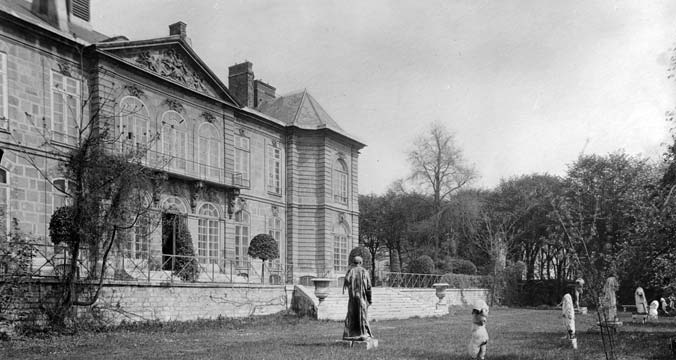 L’Hôtel Biron, côté jardin, Charles Berthelomier, circa 1910
L’Hôtel Biron, côté jardin, Charles Berthelomier, circa 1910




































































